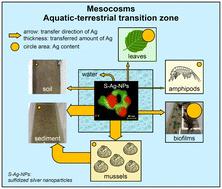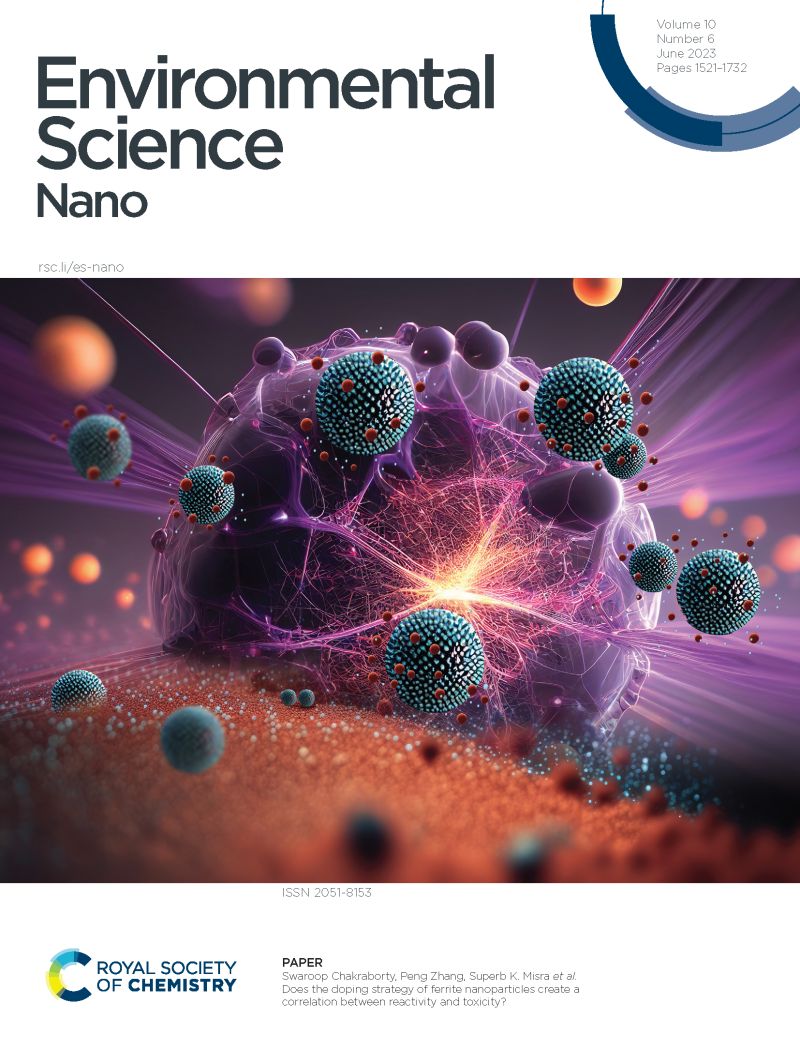硫化银纳米颗粒在非生物和生物环境隔间中的分布:一项长期洪泛区介环境研究
IF 5.1
2区 环境科学与生态学
Q1 CHEMISTRY, MULTIDISCIPLINARY
引用次数: 0
摘要
在环境研究中,与常用的原始银纳米颗粒或溶解银合成的硫化银纳米颗粒(Ag2S-NPs)相比,通过硫化银纳米颗粒(Ag-NPs)制备的硫化银纳米颗粒(S-Ag-NPs)将更真实地模拟这些纳米颗粒的释放途径及其在自然腔室中的命运,这些纳米颗粒不能完全反映环境相关状态。此外,关于S-Ag-NPs在沉积物、洪泛平原土壤、生物膜、片脚类动物和滤食性生物(双壳类)中积累的信息非常有限。在本研究中,我们利用室内生态系统模拟水陆过渡带,并考虑河漫滩地区的典型动态,评估了S-Ag-NPs在非生物和生物隔间中的分布。本研究中观察到的沉积物和生物膜中银的高积累表明,这些隔室是河流中S-Ag-NPs最有效的汇。在贻贝存在的情况下,沉积物中银的固定化增加,很可能是由于贻贝将纳米颗粒作为假粪便排出体外。源自S-Ag-NPs的银在生物膜、片脚类动物、贻贝和树叶上的富集表明,这些与环境相关的纳米颗粒的营养转移风险增加。虽然硫化银纳米粒子和原始银纳米粒子的一些特性是不同的,比如与银纳米粒子相比,s -银纳米粒子对生物膜和树叶的亲和力较低,但两种纳米粒子的其他特性是相似的,比如在沉积物和土壤中的高积累。此外,残留的纳米颗粒在河水中的高流动性似乎是S-Ag-NPs和Ag-NPs的代表,表明它们在河流中长距离运输的风险增加。本文章由计算机程序翻译,如有差异,请以英文原文为准。

Distribution of sulfidized silver nanoparticles across abiotic and biotic environmental compartments: a long-term floodplain mesocosm study
In environmental research, the application of sulfidized silver nanoparticles (S-Ag-NPs) prepared by sulfidation of silver nanoparticles (Ag-NPs) will more realistically simulate the release routes of these nanoparticles and their fate in natural compartments compared to the frequently used pristine Ag-NPs or silver sulfide nanoparticles (Ag2S-NPs) prepared by synthesis from dissolved silver which do not fully reflect the environmentally relevant state. Furthermore, the information on the accumulation of S-Ag-NPs in sediments, floodplain soils, biofilms, amphipods, and filter feeding organisms – bivalves – is extremely limited. In this study, we evaluated the distribution of S-Ag-NPs in abiotic and biotic compartments using indoor mesocosms simulating the aquatic-terrestrial transition zone and considering typical dynamics in floodplain areas. High accumulation of silver in sediments and biofilms observed in this study indicates that these compartments represent the most effective sinks for S-Ag-NPs in rivers. In the presence of mussels, immobilization of silver in sediment increased, most likely due to the rejection of nanoparticles as pseudo-feces by mussels. The enrichment of silver originating from S-Ag-NPs in/on biofilms, amphipods, mussels, and leaves suggests an enhanced risk of trophic transfer of these environmentally relevant nanoparticles. While some properties of nanoparticles are different for sulfidized and pristine Ag-NPs such as lower affinity of S-Ag-NPs to biofilms and leaves compared to Ag-NPs, other properties are similar for both nanoparticles such as high accumulation in sediments and soils. Furthermore, the high mobility of a residual nanoparticle fraction in river water seems to be representative for S-Ag-NPs and Ag-NPs indicating an enhanced risk for their long-distance transport in rivers.
求助全文
通过发布文献求助,成功后即可免费获取论文全文。
去求助
来源期刊

Environmental Science: Nano
CHEMISTRY, MULTIDISCIPLINARY-ENVIRONMENTAL SCIENCES
CiteScore
12.20
自引率
5.50%
发文量
290
审稿时长
2.1 months
期刊介绍:
Environmental Science: Nano serves as a comprehensive and high-impact peer-reviewed source of information on the design and demonstration of engineered nanomaterials for environment-based applications. It also covers the interactions between engineered, natural, and incidental nanomaterials with biological and environmental systems. This scope includes, but is not limited to, the following topic areas:
Novel nanomaterial-based applications for water, air, soil, food, and energy sustainability
Nanomaterial interactions with biological systems and nanotoxicology
Environmental fate, reactivity, and transformations of nanoscale materials
Nanoscale processes in the environment
Sustainable nanotechnology including rational nanomaterial design, life cycle assessment, risk/benefit analysis
 求助内容:
求助内容: 应助结果提醒方式:
应助结果提醒方式:


